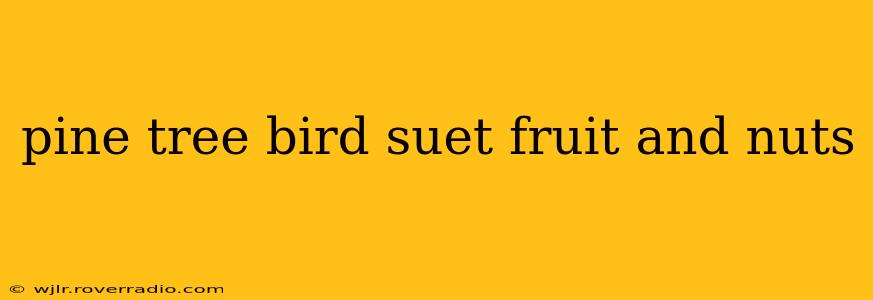Pine trees, with their majestic stature and fragrant needles, often serve as vibrant backdrops for a lively avian community. But beyond their aesthetic appeal, pine trees and their surroundings offer a crucial habitat for many birds, particularly during the colder months when natural food sources are scarce. Providing supplemental food, such as suet, fruit, and nuts, can significantly enhance the well-being of these feathered friends, especially those frequenting pine-rich areas. This guide will explore the best ways to attract and nourish birds using these food sources in pine tree environments.
What Birds Frequent Pine Trees?
Many bird species call pine trees home or utilize them for foraging and shelter. Some common examples include:
- Woodpeckers: These acrobatic birds are frequent visitors, drilling into the bark to seek insects and sap. Suet, especially those with nuts and seeds incorporated, are highly attractive to them.
- Nuthatches: Known for their upside-down foraging, nuthatches happily explore pine branches for insects and seeds. Nuts and suet cakes are excellent supplemental food options.
- Chickadees & Titmice: These small, active birds are frequent visitors to backyard feeders and are easily attracted by suet and sunflower seeds. They readily utilize pine trees for shelter and nesting.
- Crossbills: These unique birds have specialized beaks for extracting seeds from pine cones. While they primarily feed on pine seeds, supplementing with seeds and nuts can be beneficial, particularly during lean years.
- Pine Siskins & Redpolls: These finches are often found in flocks, feeding on pine seeds. Supplementing with niger seeds or nyjer seed cakes can attract them.
What Kind of Suet is Best for Pine Tree Birds?
The ideal suet for birds frequenting pine trees should offer a blend of energy-rich fats and appealing ingredients. Consider these factors:
- Fat Content: High-fat content is crucial for providing energy during cold weather.
- Ingredient Variety: A mix of nuts, seeds, dried fruit, and insects can attract a wider range of species. Look for suet blends containing peanuts, sunflower seeds, berries, and mealworms.
- Form: Suet comes in various forms: cakes, logs, or loose chunks. Cakes are convenient, while logs and loose chunks can be placed in various locations within the pine tree area.
- Placement: Mount suet feeders on sturdy tree branches away from predators or attach them to trees using appropriate methods.
What Fruits and Nuts are Good for Pine Tree Birds?
Beyond suet, providing fruits and nuts can complement their diet and attract additional species. Consider these options:
- Nuts: Peanuts (in-shell or shelled), sunflower seeds, walnuts, pecans, and almonds are all popular choices.
- Fruits: Dried cranberries, raisins, chopped apples, and berries (like blueberries and raspberries) offer a healthy and attractive supplement.
- Preparation: Offer these items in small quantities to prevent spoilage and ensure freshness. Consider using specialized feeders designed for nuts and fruit to avoid mess and waste.
How to Attract Birds to Pine Trees with Suet, Fruit and Nuts?
Successfully attracting birds requires a multifaceted approach:
- Strategic Placement: Position feeders near pine trees but in a location providing cover from predators. Avoid placement directly beneath branches to minimize droppings.
- Consistency: Regularly replenish food sources to maintain a consistent food supply.
- Water Source: Provide a nearby water source, especially important during winter months. A heated bird bath can be helpful.
- Natural Food Sources: Encourage the growth of native plants that produce berries and seeds to provide natural food sources alongside supplementary feeding.
How Often Should I Refill Bird Feeders Near Pine Trees?
The frequency of refilling bird feeders depends on the number of birds visiting and the size of the feeder. As a general guideline, check your feeders daily, especially during cold weather, and refill as needed. Larger feeders will naturally require less frequent refills. Larger quantities can be placed in larger, enclosed feeders to avoid spoilage and waste.
What are the Best Types of Bird Feeders for Pine Trees?
The ideal bird feeder for a pine tree environment should be sturdy, weather-resistant, and capable of handling various types of food. Consider these options:
- Suet feeders: These are specifically designed to hold suet cakes and often have cages or mesh to prevent squirrels from accessing the food.
- Platform feeders: These provide a flat surface for nuts and seeds.
- Tube feeders: These are well-suited for smaller seeds and often have perches for smaller birds.
- Specialized feeders: Some feeders are designed to hold specific types of fruit or nuts.
By strategically utilizing suet, fruit, and nuts, and understanding the birds that frequent pine trees, you can create a thriving backyard habitat that supports these wonderful creatures throughout the year. Remember that consistent effort and consideration of their specific needs will significantly increase your success.
